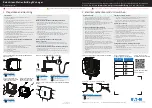
4
Important Safety Instructions
11. GROUNDING AND AC POWER CORD CONNECTION INSTRUCTIONS
a. The charger should be grounded to reduce risk of electric shock. The charger is equipped
with an electric cord with an equipment-grounding conductor and a grounding plug. The
plug must be plugged into
a 120 VAC GFCI protected (Ground Fault Circuit Interrupt)
outlet
that is properly installed and grounded in accordance with all local codes and ordinances.
DANGER
Never alter an AC cord or plug provided - If it does not fit the outlet, have a proper outlet installed
by a qualified electrician. Improper connection can result in a risk of an electric shock.
b. This battery charger is for use on a nominal 120-volt circuit, and has a grounding plug
that looks like the plug illustrated in figure A. A temporary adapter, which looks like the
adapter illustrated in figure B may be used to connect this plug to a two-pole receptacle
as shown in figure B if a properly grounded outlet is not available.
The temporary
adapter should be used only until a properly grounded GFCI protected outlet
can be installed by a qualified electrician.
DANGER
Before using an adapter as illustrated, be certain that the center screw of outlet plate is
grounded. The green-colored rigid ear or leg extending from adapter must be connected to
a properly grounded outlet - make certain it is grounded. If necessary, replace original outlet
cover plate screw with a longer screw that will secure adapter ear or lug to outlet cover plate
and make ground connection to grounded GFCI protected outlet.
Use of an adapter is not allowed in Canada. If a grounding type receptacle is not available,
do not use this appliance until the proper GFCI protected outlet is installed by a qualified electrician.
120 VAC GFCI protected (Ground Fault Circuit Interrupt)
outlet via house panel breaker or GFCI outlet (not shown)
Figure A
Grounding pin
Grounding means
Metal screw
Adapter
Figure B
Safety Instructions
3
Important Safety Instructions
5. Extension cords:
a. Pins on the plug of the extension cord are the same number, size and shape as those
on the plug of the charger.
b. Use only a properly wired extension cord in good electrical condition.
c. Use an industrial grade / heavy duty UL or CSA approved and grounded extension cord.
Check the extension cord before use for damage, bent prongs, and cuts. Replace if
damaged. Always make your extension cord connection on the charger side first.
After
connecting the extension cord to the charger, proceed to plug the extension cord
into a nearby 120 VAC GFCI protected (Ground Fault Circuit Interrupt) outlet.
Below are the manufacturer recommendations for the right size UL or CSA Approved
grounded extension cord.
ProMar1 DS 4, 5, 4/4, 5/5, 4/4/4 and 5/5/5:
i. Up to 50 feet in length; use a 3 conductor 18 AWG extension cord.
ii. 50 to 100 feet in length; use a 3 conductor 16 AWG extension cord.
iii. 100 to 150 feet in length; use a 3 conductor 14 AWG extension cord.
6. Do not operate the charger if any protective AC or DC cable insulation, DC fuse holders or
ring terminals have been damaged or compromised. Contact ProMariner immediately to
return the charger for service and repair.
7. Do not operate the charger if it has received a sharp blow, direct hit of force, been dropped
or otherwise damaged in any way. Contact ProMariner immediately to return the charger
for service and repair.
8. Do not disassemble charger. Incorrect reassembly may result in a risk of electric shock or
fire. If service or repair is required, please call ProMariner customer service at 800-824-0524
between 8:30am-5pm (EST) Monday through Friday, or via www.promariner.com. Unauthorized
attempts to service, repair or modify may result in a risk of electrical shock, fire or explosion
and will void warranty.
9. To reduce risk of electric shock, unplug charger from outlet before attempting any maintenance
or cleaning.
10.Do not expose AC power cord connection to rain or snow.
Safety Instructions





































